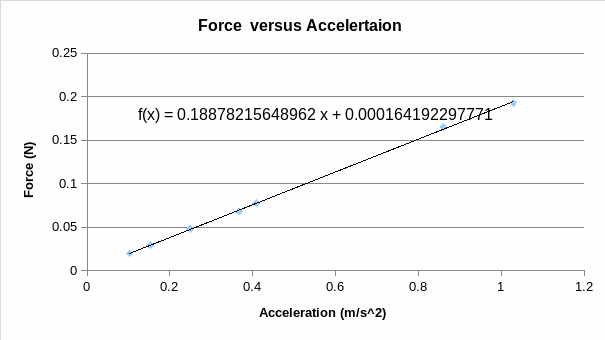Objective
The objective of the experiment is to demonstrate Newton’s second law of motion that the acceleration of an object with fixed mass is directly proportional to the net force applied to it.
Equipment/Materials
- Timer
- Pulley
- Meter stick
- Air track
- Air supply
- Cart
- Photogates
- String
- Balance
- Air track
- Air supply
Theory
According to Newton’s second law of motion, an object with a fixed mass (m) will have a uniform acceleration (a) when it experiences a net force (F).
F = ma (Equation 1)
As the experiment fixed the mass and varied the force, it demonstrated that force and acceleration have a positive correlation.

F = mg (Equation 2)
Since a string connects masses M and m, and they accelerate together in response to the same force, they all contribute to the relationship between force and mass.
F = (M + m)a (Equation 3)
The experiment increased force (F) by increasing m and decreasing M while making the total mass constant as M + m, as in equation 3.
Procedure and Analysis
The air track was set to move on a frictionless flat surface and connected to a hanging mass by a string via a pulley. The experiment was commenced by placing all masses the hanging mass holder then gradually decreased by removing them, then placing them on the cart of the air track to ensure that there is a constant mass. The masses of the mass holder and cart were measured and tabulated. The photogate and timer were used in measuring acceleration. The timer was used to record time 1 (t1) and time 2 (t2), which are times that the cart took to pass through photogates 1 and 2, respectively. The distance L was determined by measuring the distance it takes for the moving cart to turn on and off the timer. The velocity of the cart was determined using the flowing equation.
V = L/t (Equation 4)
For different masses m, times 1 and 2 were tabulated and v1 and v2 calculated from respective trials. Moreover, acceleration and force for each trial were calculated.
Results
L = 0.128 m s = 0.250m
Table 1: Masses.
Table 2: Tabulated Results.

Discussion
The experiment has successfully demonstrated Newton’s second law of motion by showing that acceleration is directly proportional to the force applied to a fixed mass of an object. The graph of force versus acceleration gave a straight line with the slope of 0.188782 and the y-intercept of 0.0001642. The graph has a straight line because the mass used in the experiment was constant while the force and acceleration were variable. In this view, the slope of the straight line is the total mass (F/a = total mass), which is 0.188782 while the y-intercept is close to zero, and thus, it is negligible.
Calculation shows that the experimental mass is 0.188782 while the theoretical mass is 0.19969. The percent discrepancy is -0.01089 kg (0.1888 – 0.019969), which is less than the theoretical value by -5.45% (-0.01089/0.19969*100). The possible causes of discrepancies could be an inaccurate measurement of masses, errors in the timing of the motion, and surface friction.
The experiment has verified one part of Newton’s second law of motion that the net force is directly proportional to the acceleration when the mass of an object is constant. However, the experiment has not verified the other part of Newton’s second law of motion that acceleration is inversely proportional to mass when the applied force is constant. To verify this part of Newton’s second law of motion, the experiment would apply a constant force on variable masses and assess the acceleration. A graph of acceleration versus mass would give a straight line with a negative slope representing a constant net force applied to the cart.
Conclusion
The experiment was successful, for it managed to demonstrate Newton’s second law of motion by using a fixed mass and variable force. The experiment demonstrated that acceleration is directly proportional to the net force when the mass of an object is constant. However, the comparison of theoretical and experimental total masses gave a discrepancy of -5.45%. The inaccuracies in the measurement of masses, timing motions, and surface friction might have contributed to the discrepancy observed. A further experiment is necessary to verify the other aspect of the law to demonstrate the negative relationship between acceleration and mass when force is constant.